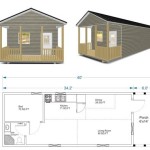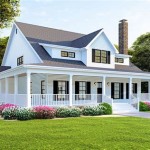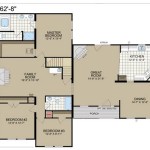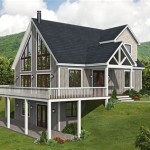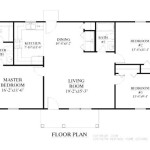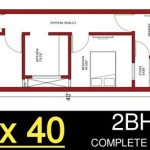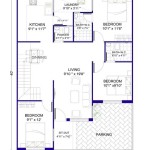Mid-Century Home Floor Plans: A Timeless Design Legacy
Mid-century modern architecture, a style prevalent from the 1930s to the 1960s, continues to captivate homeowners today. This enduring popularity stems from its clean lines, functional spaces, and connection to nature. Mid-century home floor plans are particularly notable for their unique layout and innovative use of space, reflecting the era's emphasis on simplicity and accessibility.
These homes often feature open floor plans, blurring the boundaries between living areas and maximizing natural light. Geometric shapes, large windows, and a focus on outdoor living are also characteristic elements. This article will explore the key features of mid-century home floor plans, providing an in-depth understanding of this iconic architectural style.
Open Floor Plans and Fluid Spaces
The open floor plan is a signature element of mid-century home designs. Walls are minimized, allowing for seamless transitions between the living room, dining area, and kitchen. This creates a sense of spaciousness and encourages a flow of activity throughout the home. The open floor plan also enhances natural light penetration, further brightening the interior.
The emphasis on openness is not limited to the main living areas. Mid-century home floor plans often incorporate internal courtyards or patios, extending the living space outdoors. This connection to nature is a key principle of mid-century design, blurring the lines between the house and its surrounding landscape. The fluidity of space is further emphasized by the use of sliding glass doors, which seamlessly blend the interior with the exterior.
Emphasis on Natural Light and Views
Mid-century home floor plans prioritize natural light, incorporating large windows and skylights to illuminate the interior. These windows are often strategically positioned to frame scenic views and maximize passive solar gain, reducing energy consumption. The open floor plan also contributes to the abundance of natural light by minimizing interior walls that could obstruct sunlight.
Large windows are not only functional but also serve as a design element, framing the landscape and creating a sense of openness. The use of glass throughout the home connects the interior with the exterior, blurring the boundaries between the house and its surroundings. This connection to nature is a key element of mid-century modern design, promoting a sense of well-being and connection with the environment.
Functional and Efficient Layouts
Mid-century home floor plans are designed with functionality and efficiency in mind. They utilize space strategically, maximizing every square foot while maintaining a sense of spaciousness. The open floor plan, for example, eliminates unnecessary walls and creates a free-flowing layout that accommodates various activities. The emphasis on functionality is also evident in the incorporation of built-in storage solutions and well-designed kitchens that prioritize efficiency.
Besides functionality, mid-century home floor plans also prioritize accessibility. They often feature single-level designs, eliminating stairs and creating a comfortable and easily navigable living environment. This accessibility is particularly appealing for aging in place, as it ensures the home can be enjoyed for many years to come.
Beyond the Floor Plan: Key Architectural Features
Mid-century home floor plans are only one aspect of this iconic architectural style. Other defining characteristics include:
- Flat roofs: In contrast to traditional pitched roofs, mid-century homes often feature low-pitched or flat roofs, adding to the minimalist aesthetic while also creating a sense of horizontality.
- Geometric shapes: Simple geometric shapes, such as squares, rectangles, and circles, are prevalent in mid-century architecture, adding structure and visual interest to the design.
- Use of natural materials: Mid-century homes commonly incorporate natural materials like wood, brick, and stone, contributing to the warmth and authenticity of the design. These materials are often left unfinished, highlighting their natural beauty and texture.
- Emphasis on outdoor living: Mid-century home floor plans often incorporate patios, decks, and courtyards, blurring the boundaries between the interior and the exterior. This focus on outdoor living promotes a connection with nature and extends the living space beyond the four walls of the home.
These architectural features, combined with the distinctive floor plan layouts, create homes that are both stylish and functional, reflecting the enduring appeal of mid-century modern design.

Untitled Modern Floor Plans Mid Century House

Build A House With These Mid Century Modern Floor Plans Blog Eplans Com

Mid Century Modern House Plans Houseplans Blog Com

Pin By Lynne White On Floor Plans Mid Century Modern House Craftsman Style

Designing A Mid Century Modern Home Part Ii Wildfire Interiors

Build A House With These Mid Century Modern Floor Plans Blog Eplans Com

The Basic Floor Plan Of An Alexander Mid Century Tract Homes

Untitled Mid Century Modern House Vintage Plans

Best Mid Century Modern Floor Plans And Designs Bybespoek

Mid Century Modern House Plans Created By The Architects

